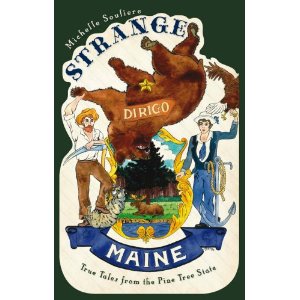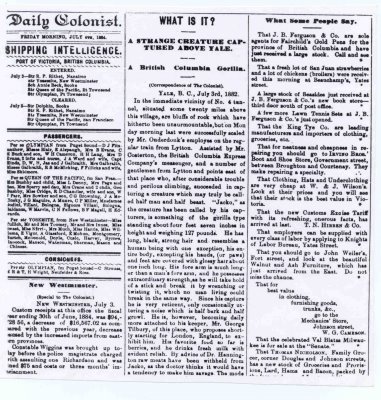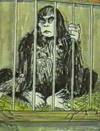Bigfoot and Railroad Trackways
Posted by: Loren Coleman on January 2nd, 2011

There is a rare story, unelaborated, the tidbit of which is currently being investigated by Strange Maine author Michelle Souliere, that tells of the finding of an “apeman” near the railroad tracks at Greenville, Maine, in 1856. It holds the promise of further intrigue. Can you help? Has any Cryptomundian ever heard of this 1856 case and knows more details?
This item has brought to mind the quite frequent place that railroads fit into such stories.
Have you ever noticed there seems to be something special going on with railroad tracks and Bigfoot?
For anyone who reads the hominological and cryptozoological literature, you will be quite familiar with the notion that railroads keep popping up in sighting accounts. Cases like the Enfield Monster of Illinois, 1973, mention the railroad tracks almost as if they are being used as the avenues of movement for the creature. In the midst of a series of Bigfoot sightings, on January 15, 1980, near Manchester, Iowa, railroad engineer Cyrii O’Brien, who was on a train at the time, saw a strange creature on all fours eating a carcass; weird six-toed tracks were found in the area later. (See a related video here.)
Rail right-of-ways are natural greenbelts for animals to employ for ease of travel. Is it any wonder that railroads are so often involved?
Railways, of course, have been used as a form of explanation, too. Various threads have been linked to the railroads in Bigfoot stories in the same fashion that the “wrecked circus train myths” were used by early news reporters to explain away unknown mystery cat sightings. Those “circus trains,” needless to say, rode the rail lines.
It will be recalled that during the “white wild man” sightings in British Columbia, in 1922, it was written at the time that “the ‘wild-men’ running at large, more or less, [have been sighted] ever since the advent of the G.T.P., [and were] supposed to have been working on the railroad construction, afterwards squatting on the wild lands abounding in this district, until they in turn become ‘wild’ themselves, according to the remoteness from supplies or from other human companions.” Source.
The stray people became the feral or wild people who became Sasquatch, we are told. The theme has been used before.
One of the most discussed historic Bigfoot-railroad cases, of course, is the Jacko incident.
The story of Jacko – that of a small, apelike, young Sasquatch said to have been captured alive in the 1800s – is a piece of folklore that refuses to die, despite a superb investigative article published in 1975, co-authored by John Green and Sabina W. Sanderson.
The investigation into the Jacko story did not began until decades later. During the 1950s, a news reporter named Brian McKelvie became interested in the then-current stories of the Sasquatch being carried by his local British Columbian papers. McKelvie searched for older reports. What he found was the Daily British Colonist July 4, 1884, article about Jacko. The account detailed the sighting of a smallish hairy creature (“something of the gorilla type”) supposedly seen and captured near Yale, British Columbia, on June 30, 1884, and housed in a local jail.
McKelvie shared the Jacko account with researchers John Green and René Dahinden. MeKelvie told them this was the only record of the event due to a fire that had destroyed other area newspapers of the time.
In 1958, John Green found and interviewed a man (August Castle) who remembered the Jacko talk of the time, but he said his parents did not take him to the jail to see the beast. Other senior citizens remembered the talk of the creature, but no one could produce any truly good evidence for or eyewitness accounts (other than the British Colonist story) of Jacko.
The story’s appearance in Ivan T. Sanderson’s 1961 Abominable Snowmen: Legend Come to Life propelled the Jacko incident into history. I dealt with the Jacko story anew in my book, Bigfoot! The True Story of Apes in America (NY: Simon and Schuster, 2003), beginning on page 41, and have written of it before on Cryptomundo, here.
Meanwhile, some of the older accounts are merely short references to the sightings of wild people (whatever that means).
For example, the appearance of a “black wild man” is noted in one old article as having been seen near a railroad station in 1870 at Chatawa, Mississippi. This seems similar to the Vincennes Monster (also said to look like a “black wild man”) seen near a railroad bridge in Indiana, in 1885.
But the question for today is, what happened in Greenville, Maine, in 1856?
BTW, when is an old report of a “wild man” in Maine not really in the state of Maine? When it’s an account from Maine, New York, of course.
In Robert Bartholomew’s and Paul Bartholomew’s Bigfoot: Encounters in New York & New England (2008), the authors detail “wild-man” sightings occurring between August and November 1883 at just such a location. They write that these encounters took place “in extreme south central New York near the small town of Maine on the western border of Broome County, northwest of Binghamton.”
This Maine (New York) creature was described as “low in stature, covered with hair, and running while bent close to the ground” with no forearms as its “arms ended at the elbows,” (p. 22). I wonder how any of the Cryptomundian artist would draw that creature?
About Loren Coleman
Loren Coleman is one of the world’s leading cryptozoologists, some say “the” leading living cryptozoologist. Certainly, he is acknowledged as the current living American researcher and writer who has most popularized cryptozoology in the late 20th and early 21st centuries.
Starting his fieldwork and investigations in 1960, after traveling and trekking extensively in pursuit of cryptozoological mysteries, Coleman began writing to share his experiences in 1969. An honorary member of Ivan T. Sanderson’s Society for the Investigation of the Unexplained in the 1970s, Coleman has been bestowed with similar honorary memberships of the North Idaho College Cryptozoology Club in 1983, and in subsequent years, that of the British Columbia Scientific Cryptozoology Club, CryptoSafari International, and other international organizations. He was also a Life Member and Benefactor of the International Society of Cryptozoology (now-defunct).
Loren Coleman’s daily blog, as a member of the Cryptomundo Team, served as an ongoing avenue of communication for the ever-growing body of cryptozoo news from 2005 through 2013. He returned as an infrequent contributor beginning Halloween week of 2015.
Coleman is the founder in 2003, and current director of the International Cryptozoology Museum in Portland, Maine.












I wish that I could help; but I have no idea what happened in Greenville, Maine, in 1856.
However, the BFRO has an interesting account of a 2009 sighting by a hunter, who was riding in a train at the time.
It is entitled, “Man sees large, hair-covered figure while riding on train near the Cascade Tunnel.”
(The sighting occurred in Washington State.)
Here is the link:
http://www.bfro.net/GDB/show_report.asp?id=26403
For several years now, I’ve toyed with the very same premise: railroad tracks as avenues of travel. I’ve noticed a correlation in the literature to creeks, streams, and rivers as well. It would be interesting to see a team begin to investigate these aspects of the reports, perhaps with trailcams set up in these locations.
That makes sense on a lot of fronts. It obviously would be easier traveling across country (the BF does appear to be nomadic…or at least always on the move and never staying in one spot for too long).
In addition, while being easier to travel, the actual privacy is good too–a lot of miles of track don’t go anywhere near human populations, making it good ground to travel unmolested.
And having walked tracks hunting in my youth, there’s often other animals in the vicinity, and I often came upon bushes of berries in a wide variety (whether this was incidental to my area, or my environment, or typical of growth, I don’t know, but I’ve observed it here).
I’d say the same was true of creeks and rivers. A good source of easy travel, relative security, and food, all make the railroad tracks seem pretty logical as a place to gravitate to. Who knows, perhaps the BFs are curious about the trains and people too–they could watch from the relative safety of the woods.
I will keep that in mind when I get to hunting for BF…with a camera and binoculars.
SHJ
Re: “Man sees large, hair-covered figure while riding on train near the Cascade Tunnel.”
I hope the large, hair-covered figure had done the right thing and purchased a ticket (sorry…).
One thing to consider that I have observed is deer kills by trains especially high speed rail. Easy pickens for scavengers.
Second thing to consider regarding “black wildman sightings” in 1856. Slaves were held in the north and the obvious route to Canada is north. Railroad tracks are also natural navigation aids; much more predictable than rivers since they always lead to human habitation.
Railways could indeed be productive areas to search.
You live next to a railroad track? Didn’t think so; not a whole lot of folks do, and railroads aren’t exactly laid out to keep the maximum number of people up at night getting rumbled and whistle-blasted out of bed. Translation: they tend to be pretty remote, along significant stretches, from concentrations of observers, while still allowing straight-line travel at good speed over generally cooperative terrain.
This report from the TBRC talks about several things that might make railways appealing to an animal that covers a wide range in search of food:
I’ve noticed this too.
I’m only 17, but I have done some investigating, and what I’ve been told is an unhealthy amount of reading about cryptozoology in general; my biggest focuses are on bigfoot and related species.
I was at this library lecture done by the great Wisconsin cryptozoologist and anomalist Chad Lewis, when a woman told us (the collective group) about a sighting she and her ten year old son had. In basic they where on the Eisenbahn trail, the german word for railroad, which used to be a railroad. They where biking, and saw a large hairy black animal on hind legs that seemed to be watching them when they scared it off, and it ran into a clearing and up a hill at highspeeds. They seemed genuine, and it was only a year after a rash of sightings around the same area (a state forest).
Here is some more info on the trail and surrounding areas.
Dear Loren –
Hope this finds you and yours well.
A number of anomalous events seem to occur around railroad tracks. Among these are spooklights (ghost lights) and various strange creature encounters. Not only is seeing not believing, it isn’t even close to understanding.
My best to you and yours in 2011.
Yours in research,
Robert A. Goerman
“Do what you can, with what you have, where you are.”
–Theodore Roosevelt